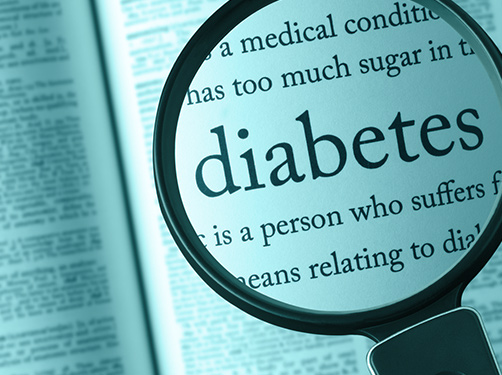Type 2 diabetes: Causes and development
Scientific support: Dr. Theresia Sarabhai
Type 2 diabetes develops over an extended period, often without the affected individuals experiencing any symptoms of the disease. In type 2 diabetes, the hormone insulin becomes less effective at the body's cells. In addition, the pancreas releases less insulin. As a result, less sugar (glucose) can enter the body's cells and remains in the blood.
Researchers are actively investigating the causes and reasons behind the development of type 2 diabetes. Apart from genetic predisposition, an unhealthy lifestyle with factors such as being overweight, lack of physical activity, and poor nutrition plays a role.

Contents
1. What increases the risk of type 2 diabetes?
Several factors contribute to the occurrence of type 2 diabetes. A distinction can be made between modifiable and non-modifiable factors. Non-modifiable risk factors include age and genetic predisposition. An unhealthy lifestyle, on the other hand, is a modifiable risk factor.
The following factors contribute to type 2 diabetes:
- High incidence of type 2 diabetes in the family
- Old age
- Being overweight or obese, especially in the abdominal region
- Increased blood pressure
- Increased blood lipids (e.g., cholesterol)
- Unhealthy lifestyle
- High-energy, low-fiber diet
- Lack of physical exercise
- Smoking
- Alcohol
- Diabetes in pregnancy
- Drugs that impair glucose metabolism (such as cortisone)
- Fatty liver disease
- Depression
- Sleep apnea syndrome (breathing disorders during sleep)
- Other hormonal diseases (such as polycystic ovary syndrome)
- Environmental factors (e.g., air pollution and noise)
Is type 2 diabetes hereditary?
Genetic predisposition plays a significant role in the development of type 2 diabetes. Individuals with a family history of type 2 diabetes have an increased risk of developing the disease compared to those without a genetic predisposition. The risk is
- approximately 1.7 times higher with one parent having type 2 diabetes, and
- almost 3 times higher when both parents have type 2 diabetes.
However, only a predisposition to type 2 diabetes is inherited through genes, not the disease itself. Type 2 diabetes typically develops when additional risk factors, such as an unhealthy lifestyle, are present.
What role does lifestyle play in type 2 diabetes?
In addition to genetic predisposition, an unhealthy lifestyle often contributes to the development of type 2 diabetes. This includes factors such as a high-calorie, low-fiber diet, lack of physical activity, being overweight — especially in the abdominal region — and smoking.
The risk of developing type 2 diabetes is more than 3 times higher in people who are obese. The duration and degree of obesity are crucial factors. Approximately 80 out of 100 individuals (80 percent) with newly diagnosed type 2 diabetes are overweight.
Read more about obesity and how it can lead to type 2 diabetes here.
Good to know:
The Body Mass Index (BMI) is a measure of the ratio of body weight to height. It is calculated as follows:
BMI = body weight in kilograms (kg) : height in meters squared (m²)
According to the World Health Organization (WHO), adults with a BMI between 18.5 and 24.9 kg/m² are considered normal weight. A BMI of 25 to 29.9 kg/m² is defined as overweight. A BMI of 30 kg/m² or higher is classified as obese.
Smoking can also contribute to the development of type 2 diabetes. The extent to which smoking increases the risk of type 2 diabetes depends on the number of cigarettes smoked per day and how long a person has been smoking.
Learn more about how smoking affects blood sugar levels in our "Preventing Diabetes" portal.
2. How can I determine if I have an increased risk of type 2 diabetes?
In Germany, there are two scientifically validated and recognized questionnaires available to assess the personal risk of type 2 diabetes.
The German Diabetes Risk Score was developed by the German Institute of Nutritional Research Potsdam-Rehbrücke (DIfE) and the German Center for Diabetes Research (DZD). Based on individual information, the risk of developing type 2 diabetes within the next 10 years is determined. In addition to risk assessment, the German Diabetes Risk Score provides an overview of factors already positively impacting diabetes risk and suggests ways to further reduce individual risk.
Click here to access the German Diabetes Risk Score.
Another tool for determining the risk of type 2 diabetes is the FINDRISC Diabetes Risk Calculator. Developed in Finland, this questionnaire is available in 9 languages. It consists of 8 questions to determine individual risk of developing type 2 diabetes in the next 10 years.
Click here to access the FINDRISC Diabetes Risk Calculator (Link in German).
3. What do I do if I have an increased risk of type 2 diabetes?
If you have an increased risk of developing type 2 diabetes, lifestyle adjustments can often help counteract it. A healthy and balanced diet, along with regular exercise, can prevent or at least delay the development of type 2 diabetes. Simultaneously, a healthy lifestyle can also impact body weight, further reducing the risk of diabetes.
Current studies on the prevention of type 2 diabetes
Numerous risk factors for type 2 diabetes are already known. Additional factors that can influence the development or progression of type 2 diabetes are being investigated through clinical studies. The causes of how these individual factors increase or decrease diabetes risk are only partially understood. Furthermore, not all individuals with an increased risk of type 2 diabetes respond equally well to certain lifestyle adjustments.
The goal of the clinical studies is to prevent type 2 diabetes and develop individual preventive measures.
4. How does type 2 diabetes develop?
In type 2 diabetes, insulin no longer functions properly in the body's cells. Insulin is a vital hormone in the human body. It is produced in the beta cells of the islets of Langerhans in the pancreas. The pancreas is located in the upper abdomen behind the stomach.
After a meal, the pancreas releases insulin into the blood. Insulin ensures that sugar (glucose) from food can be absorbed into the body's cells, such as the liver, muscles, or fat tissue. Sugar serves as vital energy for the cells.
In type 2 diabetes, 2 processes in sugar metabolism are disrupted, causing blood sugar to rise:
- Insulin can only weakly or insufficiently act on the cells of various organs. This results in the sugar not being absorbed into the body's cells and remaining in the blood. There is known as insulin resistance.
- Because the body's cells respond weakly to insulin, the pancreas releases more insulin to lower blood sugar levels. This high effort leads to the gradual exhaustion of the insulin-producing beta cells in the pancreas. They no longer produce enough insulin, and insufficient insulin is released into the bloodstream. This results in insulin deficiency.
Experts also refer to this as relative insulin deficiency because the pancreas still releases insulin. However, the amount of insulin is no longer sufficient for insulin-resistant body cells to absorb sugar from the blood.
What is prediabetes?
Type 2 diabetes develops gradually over a long period of time. Before individuals develop the disease, they often have the precursor to type 2 diabetes, known as prediabetes, for a long time without realizing it. People with prediabetes already have elevated blood sugar levels. However, the values are not yet high enough for experts to speak of diabetes. This condition is also referred to as "impaired glucose tolerance" or "abnormal fasting blood sugar."
Due to elevated blood sugar levels, individuals with prediabetes have a significantly increased risk of developing type 2 diabetes later on. However, people with prediabetes can often prevent the development of type 2 diabetes through measures such as regular exercise, a healthy and balanced diet, and weight loss.
Learn more about prediabetes on our "Preventing Diabetes" portal.
What is insulin resistance?
Long before individuals develop type 2 diabetes or prediabetes, they often already have insulin resistance. In insulin resistance, cells — especially in muscles, liver, and fat tissue — no longer respond as sensitively to the hormone insulin. As a result, insulin can no longer effectively transport sugar from the blood into the body's cells.
The development of insulin resistance is influenced by genetic predisposition in the family, as well as certain lifestyle habits, such as lack of physical activity, unhealthy and high-calorie diet, and being overweight — specifically in the abdominal region.
There is often a time lag of several years to decades between the onset of insulin resistance and the development of high blood glucose levels. During this phase, there are initially only very mild, often imperceptible changes in certain functions of sugar metabolism.
In addition to increasing the risk of type 2 diabetes, insulin resistance also raises the risk of hypertension, cardiovascular diseases, lipid metabolism disorders, and obesity. When these symptoms or conditions occur at the same time, experts refer to it as "metabolic syndrome."
More information about insulin resistance can be found here.
Sources:
American Diabetes Association: 2. Classification and Diagnosis of Diabetes: Standards of Medical Care in Diabetes - 2023. In: Diabetes Care, 2023, 46: S19-S40
Bundesärztekammer et al.: Nationale Versorgungsleitlinie Typ-2-Diabetes. Langfassung. Version 3.0. 2023
Bundesärztekammer et al.: Nationale Versorgungsleitlinie Therapie des Typ-2-Diabetes. Langfassung. 1. Auflage. Version 4. 2014 (Gültigkeit abgelaufen, in Überarbeitung)
Bundesärztekammer et al.: Patientenleitlinie zur Nationalen Versorgungsleitlinie Therapie des Typ-2-Diabetes. 1. Auflage. Version 1. 2015
Deutsche Adipositas-Gesellschaft et al.: Interdisziplinäre Leitlinie der Qualität S3 zur „Prävention und Therapie der Adipositas“. Version 2.0. 2014 (Gültigkeit abgelaufen, in Überarbeitung)
Fritsche, A. et al.: Different Effects of Lifestyle Intervention in High- and Low-Risk Prediabetes: Results of the Randomized Controlled Prediabetes Lifestyle Intervention Study (PLIS). In: Diabetes, 2021, 70: 2785-2795
James, D. E. et al.: The aetiology and molecular landscape of insulin resistance. In: Nat Rev Mol Cell Biol, 2021, 22: 751-771
Landgraf, R. et al.: Therapie des Typ-2-Diabetes. In: Diabetologie, 2022, 17: S159-S204
Lean, M. E. J. et al.: Durability of a primary care-led weight-management intervention for remission of type 2 diabetes: 2-year results of the DiRECT open-label, cluster-randomised trial. In: Lancet Diabetes Endocrinol, 2019, 7: 344-355
Lindström, J. et al.: The diabetes risk score: a practical tool to predict type 2 diabetes risk. In: Diabetes Care, 2003, 26: 725-731
Maddatu, J. et al.: Smoking and the Risk of Type 2 Diabetes. In: Transl Res, 2017, 184: 101-107
Mühlenbruch, K. et al.: Update of the German Diabetes Risk Score and external validation in the German MONICA/KORA study. In: Diabetes Res Clin Pract, 2014, 104: 459-466
Paprott, R. et al.: Validation of the German Diabetes Risk Score among the general adult population: findings from the German Health Interview and Examination Surveys. In: BMJ Open Diabetes Res Care, 2016, 4: e000280
Sandforth, A. et al.: Mechanisms of weight loss-induced remission of prediabetes: A Post hoc Analysis of the Randomized Controlled Multicenter Prediabetes Lifestyle Intervention Study (PLIS). In: Lancet Diabetes Endocrinol, 2023, 11: 798-810
Schiborn, C. et al.: German Diabetes Risk Score for the Determination of the Individual Type 2 Diabetes Risk. In: Dtsch Arztebl Int, 2022, 119: 651-657
Schulze, M. B. et al.: An Accurate Risk Score Based on Anthropometric, Dietary, and Lifestyle Factors to Predict the Development of Type 2 Diabetes. In: Diabetes Care, 2007, 30: 510-515
Schuppenies, A. et al.: FINDRISK: Finde das Risiko! Entwicklung eines Fragebogens zur Einschätzung des Diabetesrisikos. In: Ernährungs-Umschau, 2006, 53: 386-389
As of: 28.12.2023







